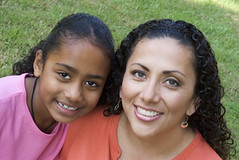Over the years, I have often heard accounts of discrimination against dark-skinned women from various sources. Darker victims of colorism frequently express their pain and frustration at backhanded compliments such as, “you're pretty for a dark-skinned girl”. They discuss their feelings of being invisible and overlooked when a woman of a lighter hue walks into the room. They want, like any other woman, to have their unique beauty appreciated. Some young women erroneously believe that the grass is greener on the other side without realizing that this is not always true. Colorism is just one of the symptoms of racism and it goes both ways. Women of color come in various shades from the lightest end of the spectrum to the darkest. Although light skin does carry a modicum of privilege in some instances, it seems that there is very little acknowledgment of how colorism affects both sides. Colorism continues to be perpetuated to this day. It occurs when we praise the physical attributes of one child while ignoring or even belittling another. It occurs when we shun potential friends and lovers based on factors such as complexion and hair texture. It occurs when we make negative assumptions about another woman because her very appearance stirs up painful memories of being picked on or chosen last or not chosen at all.
 |
| Image Credit: Jason Stitt/Fotolia |
As a woman of mixed race, I have a somewhat different perspective on colorism. My fair skin and ambiguous looks have elicited many reactions throughout my life, and only a handful have been positive. Even when the reactions were positive, I detected a hint of animosity. I grew up in a Jamaican family, seeing my darker cousin receive special treatment while I was made to feel deeply ashamed of my light skin. She was, and still is, considered the “pretty” one. Unlike me, she possesses the hair type coveted by some members of the Black community. I recall numerous times when her soft, flowing curls and deep brown skin were openly admired, while my kinky hair and creamy complexion were objects of scorn. It is difficult to be caught in the middle of racism from whites and colorism from other minorities. Many light-skinned women can attest to being accused of thinking they are “all that” or being called “redbone”-which, by the way, is not the compliment that some people think it is. I have had darker individuals attempt to tear me down as a way to level the playing field or correct perceived injustices.
My mother has also shared stories with me about her experiences as a biracial woman. There was one chilling incident that occurred about fifteen years ago, when four dark-skinned women threw rocks at her car and shouted insults. They threatened to beat her and cut her hair. She was simply driving down the street and minding her own business. I believe that colorism, as it relates to beauty standards in America, played a part in this. These women did not know her, but her appearance obviously stirred anger within them. Perhaps they were made to feel inferior as children and this developed into hostility for light-skinned women.
As I grew older, my experiences were similar to hers. I came to realize that colorism hurts us all. No one should have to apologize for the way they look. No one should be made to feel that their features are inherently ugly and that their skin or hair is somehow a curse. Being light-skinned might come with benefits sometimes, but in my experience, it does not guarantee a life of smooth sailing. Like many of my darker sisters, I often feel both objectified and invisible. However, I no longer view colorism only in terms of how it affects those darker than me. It goes both ways and we can choose to fight back against color prejudice in all forms, instead of perpetuating it and promoting division. We can stand in solidarity with one another to prevent future generations of young girls feeling that they are defined by the color of their skin and the texture of their hair. We can modify our actions and our language to ensure that we do not continue the cycle of ignorance by assigning value judgments like “good” or “bad” to certain features. We can recognize that there is worth in others as well as within ourselves. We can listen without judging and, above all-we can teach our daughters that whether they are light, dark, or in between, they are beautiful.
No comments:
Post a Comment